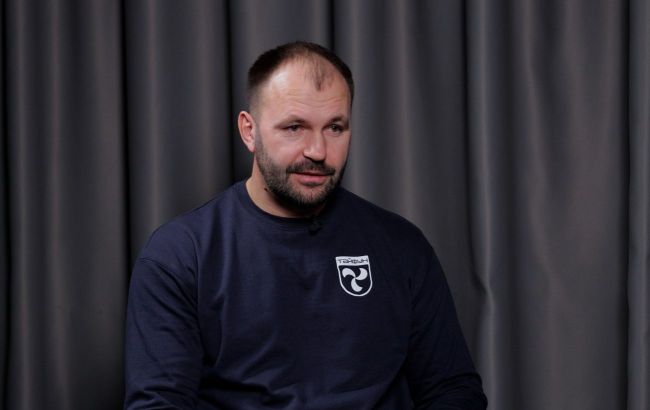Pavlo Hvozdenko, deputy commander of Typhoon unit: Former gamers destroyed Russian Borisoglebsk-2
 Pavlo Hvozdenko, deputy commander of the Typhoon special forces unit (photo: RBC-Ukraine)
Pavlo Hvozdenko, deputy commander of the Typhoon special forces unit (photo: RBC-Ukraine)
The special purpose unit of unmanned systems Typhoon of the National Guard works in the hottest spots of the front. The deputy commander of the special unit, Pavlo Hvozdenko, in an interview with RBC-Ukraine, told how the fighters managed to destroy enemy equipment worth millions of dollars and what helped to stop the Russian offensive on Pokrovsk.
Takeaways:
- How did the fighters of Typhoon eliminate a powerful Russian EW complex near Pokrovsk?
- Why are gamers recruited into the unit?
- How was the Russian offensive on Pokrovsk stopped?
- Where does the Typhoon unit operate, and how does it interact with other units?
In November, Ukrainian forces achieved a significant victory, destroying one of the Russian army's most powerful electronic warfare systems – the Borisoglebsk-2 complex.
According to the Deputy Commander of the special unit Typhoon Pavlo Hvozdenko, this operation became a turning point in restraining the enemy near Pokrovsk. How the special operation went and what made it special – the deputy commander of the Typhoon unit told RBC-Ukraine.
Creation of the special unit
The special unit Typhoon is a rather young unit but with a long combat history. The project of creating the unit started a year ago, at the beginning of summer, becoming the third special purpose unit in the National Guard. The backbone of the team consisted of individuals with relevant experience, and official recruitment to Typhoon began at the start of September.
Unlike the previous, more classified units, the recruitment to the Typhoon unit was accompanied by an active information campaign, says the deputy commander.
"Previously, such units were more classified, and, in principle, there was very little information in the information space regarding such projects. Due to the fact that it was already difficult to find people for the team because we saw problems with mobilization, there were not so many willing people anymore. Accordingly, the decision was made to advertise this story more," says Hvozdenko.
Thanks to this, it was possible to quickly recruit personnel who, after training, had already joined the combat crews and performed tasks at the front.
Special selection
Since the unit specializes in working with unmanned systems, the selection of candidates had its own features. Gender and age did not have significant impact, as this is a specialized work. "Preference was given not only to physically trained individuals but also to those who had skills in working with drones, engineering experience, or were gamers," the deputy commander notes.
This is explained by the fact that controlling drones requires specific technical skills and quick reaction. Hvozdenko emphasizes that the key factor is self-motivation: even without previous experience, but with strong desire, a person can master the necessary skills.

The main task of the special unit is to support the brigades that hold the front – Pavlo Hvozdenko
Typhoon – where it's hardest
The main task of the Typhoon unit is to support the brigades that hold the line of defense. In critical situations, when the enemy advances with the use of a large amount of equipment and manpower, the special forces go in that direction and help stabilize the situation.
"Our crews work in the hottest directions, work quite effectively. Their main task is to stabilize the situation, not to let the enemy move forward," says Hvozdenko.
The unit was formed from a new team, although about 20 people transferred from the Omega unit of the National Guard, having significant combat experience. This allowed to quickly and effectively organize the work.
"Our team is very self-motivated, and that’s cool because you can’t lower your pace when you see how people around you give their all, and you understand that you must stay in shape. I’m already a bit over 40, but still try not to fall behind. Because when you are also the deputy commander – you’re the one doing combat work," says Pavlo.
Strike at the technical heart of the enemy – Borisoglebsk-2
According to the special forces, the Russian electronic warfare complex Borisoglebsk-2 is one of the most expensive and effective means of countering drones and communication. At the beginning of the war, Russia had 14 such systems. At the time of the operation, three of them had already been destroyed, and the fourth became the trophy of Ukrainian fighters in the Pokrovsk area.
"We couldn’t believe that we managed to detect such a serious object. But after nine precise combat flights – the complex was destroyed," recalls the interlocutor.
The operation became possible thanks to the precise work of the intelligence of the Chervona Kalyna brigade and effective coordination with the drone pilots.
Why was this operation unique? According to the deputy commander, the key success factor was that at the moment of the strike, Borisoglebsk-2 was not yet turned on. Otherwise, the drone wouldn’t even have been able to approach: the system jams everything around, including its own equipment of the Russian Federation. This became its weak spot.
"If it had been activated, we wouldn’t have had a chance. But the Russians cannot operate it constantly, because even their own signals are jammed," explains Hvozdenko.
According to him, the destruction of this complex became not only symbolic but also a strategic victory, which significantly influenced the course of events in Donbas.

The whole team of the special unit is very motivated, says the deputy commander
Battle for Pokrovsk: how the Russian offensive was stopped
Simultaneously with the operation to destroy the complex, the Typhoon unit participated in the defense of Pokrovsk. This is a direction where Russia tried to advance toward Kostyantynivka to cut off the logistical routes of a significant section of the eastern front.
The enemy employed infantry, armored vehicles, and EW. However, thanks to a well-coordinated defensive strategy, the widespread use of FPV drones, and fruitful cooperation with other Ukrainian units, the defenders managed to hold back the onslaught.
"Without drones, it would have been impossible to hold the city. Infantry, UAV units, and commanders combined efforts not to allow the enemy to advance. Although certain mistakes were made, the main result is obvious – Pokrovsk remains under Ukraine’s control," explains Hvozdenko.
Interaction with the infantry, which held positions during massive attacks, was especially important. The unit commander admits: despite the fact that 90% of the effectiveness is ensured by drones, the main psychological and physical burden falls precisely on the infantry.
"In general, the destruction of such an expensive and strategically important complex as Borisoglebsk-2 and the successful defense of Pokrovsk is an example of how synergy between intelligence, drones, and command cohesion gives real results at the front," notes Pavlo.
Operations to strike enemy equipment
The Typhoon team regularly performs combat missions to destroy the enemy’s heavy equipment: tanks, IFVs, trucks, artillery, MLRS, and logistics columns. According to Hvozdenko, such operations are carried out daily, and sometimes – with dozens of strikes per day.
"There was a case when at night our crews literally 'took off for a hunt' and stumbled upon a column. The first tank was destroyed – the rest turned around and fled," the officer said.
Such operations are carried out in close coordination with artillery and infantry, and the effectiveness of strikes is documented with video and photo evidence. The enemy command, for its part, constantly tries to change tactics, reducing the amount of equipment at the front to avoid losses.
.jpg)
Typhoon unit regularly performs combat missions to destroy the enemy’s heavy equipment
"The main targets of the unit are supply columns with fuel and ammunition, tanks and APCs that are moving out, also – artillery crews and MLRS, EW and air defense, and sometimes even watercraft and pontoon crossings," lists Hvozdenko.
Thanks to improved reconnaissance and rapid data transfer, Typhoon's strike drones often destroy enemy equipment before it even enters battle. "As soon as the enemy starts 'moving,' we already know the coordinates and wait. The crew receives the task – and the equipment burns," says Hvozdenko.
Drones against armor – technologies that change the course of war
Since the beginning of the full-scale invasion, Ukraine has made a technological breakthrough in the field of unmanned aviation. If earlier drones were used mainly as scouts, today this is a full-fledged strike force, which significantly changed the balance of forces on the battlefield.
The special unit Typhoon is one of the leaders in the use of the latest UAVs in combat conditions. According to Hvozdenko, it was drones that became the main instrument of containment and destruction of Russian manpower and equipment. Currently, the range of flights has increased to 65+ kilometers, and the goal is to reach 100 km. This allows to destroy equipment that the enemy withdraws deep into the rear.
"If earlier the drone flew a maximum of 15 kilometers, now we fly 65 kilometers, we plan operations at a distance of up to 100 kilometers. Today, we already speak about tens of kilometers and pinpoint strikes on logistics. This is already a completely different level of war," he notes.
Currently, in the detachment, FPV kamikaze drones with real-time video transmission are in service. They are used for destruction of infantry, light-armored equipment, observation posts, and dugouts. Their main advantage is maneuverability and accuracy. In the unit's use, there are also bomber drones of airplane type.
"These are large drones that drop ammunition from height. Most often work at night, unnoticed by enemy air defense. Ideal for strikes on rear positions, EW, warehouses, and equipment," says Pavlo.
The defense forces also massively use drones on fiber-optic cable – a new type of device that does not emit radio signals and, accordingly, is not subject to jamming. They work in especially challenging sections of the front, where the enemy employs powerful electronic warfare tactics.
War does not stand still, and constant improvement is necessary for both the drones themselves and the munitions. "FPV drones are equipped with thermobaric charges that have high destructive power. In addition, private Ukrainian manufacturers produce munitions specially for different tasks: anti-tank, anti-personnel, explosive," notes Hvozdenko.

The special unit Typhoon invites to join the team (facebook.com/zagintaifunua)
Why it is important to join the army right now
The unit is expanding and actively recruiting new people – from pilots to engineers. There are no special age requirements: the main thing is motivation and desire to learn. All newcomers undergo combat training and get into the Typhoon team without the risk of being transferred to other units.
"We are building a team of leaders. Here everyone is in their place – pilot, engineer, and scout," emphasizes the deputy commander.
To join the special unit:
-
Go to the site typhoon.ua
-
Fill out the questionnaire
-
Wait for feedback – a specialist will contact you
-
Undergo combat training (BZVP) and become part of the team
"Ukraine needs not only equipment but also people who are ready to use it. If you are not ready for assault – join the UAV unit. If you cannot fight – help with donations. Victory depends on each of us!" says Hvozdenko.

